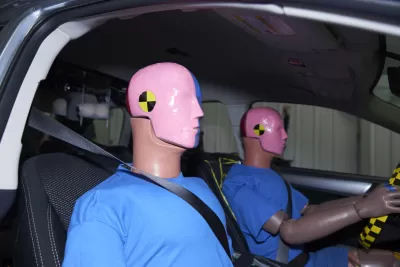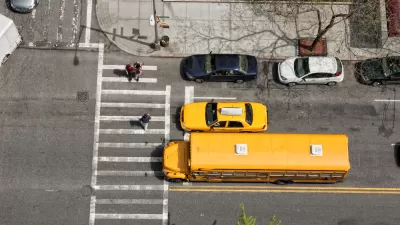New U.S. vehicle safety ratings will indicate how well driver-assistance tech and pedestrian detection mechanisms.

Starting in 2026, U.S. vehicle safety ratings will include information on driver-assistance technologies and pedestrian protection mechanisms, reports Tom Krisher for the Associated Press.
The safety ratings currently in place, which were introduced in 1978, are based on crash tests that measure the effects of crashes on passengers inside the car. Now, ratings will also include “pedestrian automatic emergency braking, lane-keeping assist, blind spot warning, and intervention if a driver tries to move toward a vehicle in a blind spot.”
The added features will receive a pass or fail grade before the system is expanded to more nuanced ratings. U.S. Transportation Secretary Pete Buttigieg says the hope is that carmakers will use these ratings to compete for customers in the same way they do with crash test ratings.
The new rules also tighten regulations around existing safety features such as automatic emergency braking and set design standards for pedestrian safety.
FULL STORY: US to add features such as blind spot warnings and pedestrian detection to vehicle crash ratings

Planetizen Federal Action Tracker
A weekly monitor of how Trump’s orders and actions are impacting planners and planning in America.

DARTSpace Platform Streamlines Dallas TOD Application Process
The Dallas transit agency hopes a shorter permitting timeline will boost transit-oriented development around rail stations.

Congressman Proposes Bill to Rename DC Metro “Trump Train”
The Make Autorail Great Again Act would withhold federal funding to the system until the Washington Metropolitan Area Transit Authority (WMATA), rebrands as the Washington Metropolitan Authority for Greater Access (WMAGA).

Supreme Court Ruling in Pipeline Case Guts Federal Environmental Law
The decision limits the scope of a federal law that mandates extensive environmental impact reviews of energy, infrastructure, and transportation projects.

Texas State Bills to Defund Dallas Transit Die
DART would have seen a 30% service cut, $230M annual losses had the bills survived.

Bikeshare for the Win: Team Pedals to London Cricket Match, Beats Rivals Stuck in Traffic
While their opponents sat in gridlock, England's national cricket team hopped Lime bikes, riding to a 3-0 victory.
Urban Design for Planners 1: Software Tools
This six-course series explores essential urban design concepts using open source software and equips planners with the tools they need to participate fully in the urban design process.
Planning for Universal Design
Learn the tools for implementing Universal Design in planning regulations.
Roanoke Valley-Alleghany Regional Commission
City of Mt Shasta
City of Camden Redevelopment Agency
City of Astoria
Transportation Research & Education Center (TREC) at Portland State University
US High Speed Rail Association
City of Camden Redevelopment Agency
Municipality of Princeton (NJ)





























